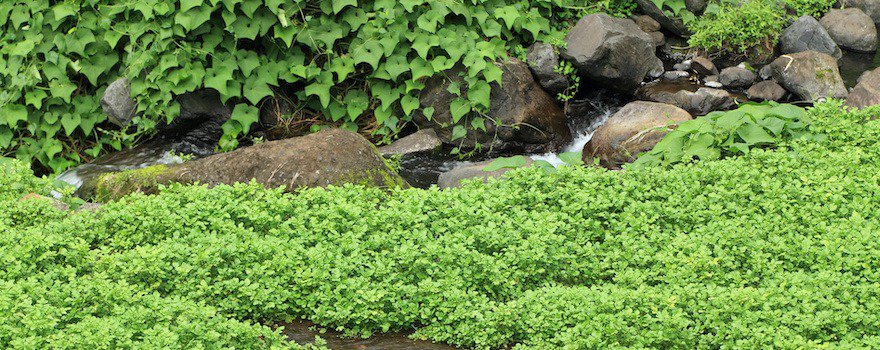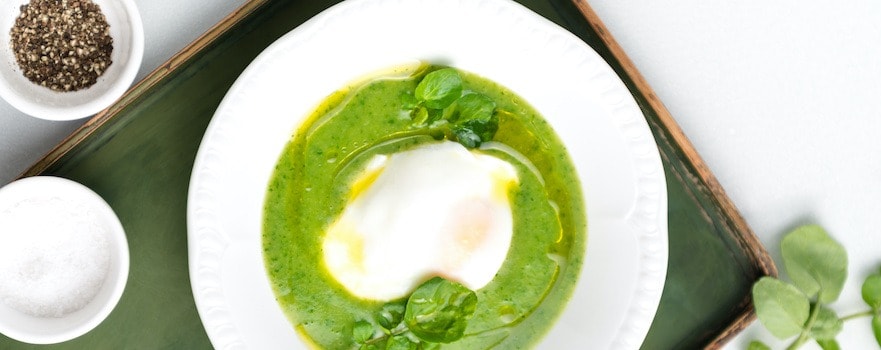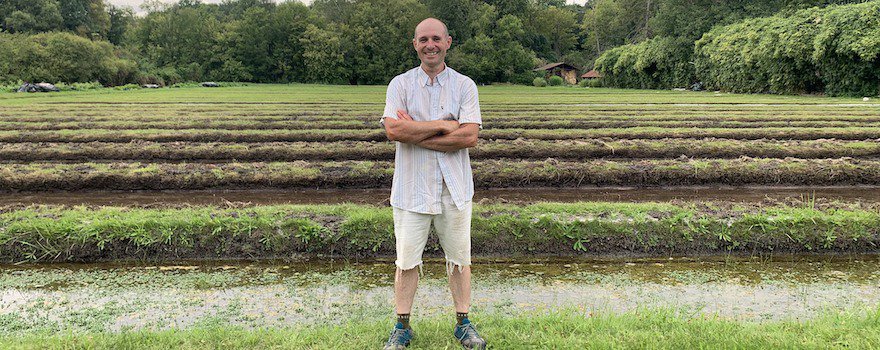BENEFITS OF WATERCRESS
✓ Antioxidant
✓ Protects eyes
✓ Strengthens bones
✓ Helps regulate blood sugar
✓ Potentially anti-cancer
What is watercress?
Watercress (Nasturtium officinale), also known as “fountain cress,” belongs to the Brassicaceae family like cabbage, turnip, or maca. It is a semi-aquatic plant that grows in floodable soils, ponds, streams, or ditches. This variety of watercress should not be confused with garden cress (Barbarea verna) or pepper cress (Lepidium sativum), which grow in open soil.
It is naturally present in Europe, Asia, and North Africa, up to 2000 m in altitude. It grows thanks to small roots at the water’s bottom that draw necessary nutrients in depth. Its stems are creeping and can measure up to 2 m long.

Watercress produces round and glossy dark green leaves, sometimes with a purple tinge, which are harvested in winter and consumed in cooking. After flowering (from April to September), it forms siliques, capsules each containing small reddish-brown seeds.
Watercress has been consumed since ancient times for its taste qualities, as well as for its nutritional richness and medicinal virtues.
According to this review, it is an integral part of traditional medicine in Iran, Azerbaijan, Morocco, and Mauritius. Both the leaves and the seeds are used. In the 19th century, it was sold on the streets of Paris for its fortifying virtues. In France, it is mostly harvested today in Essonne and Aquitaine.
Nowadays, watercress is recognized as having antioxidant action and benefits for eye and bone health. It also shows an anti-cancer effect and helps to regulate blood sugar in diabetic people.
Nutritional Composition
- 9 essential amino acids
- Vitamins: provitamin A (beta-carotene), B (B1, B2, B3, B5, B6, B9), C, E, K
- Minerals and trace elements: iron, calcium, potassium, zinc, phosphorus, copper, sulfur, sodium, magnesium…
- Fatty acids: omega-3
- Antioxidants: carotenoids (lutein, zeaxanthin), flavonoids (kaempferol, quercetin)
- Glucosinolates
- Isothiocyanates: sulforaphane, phenylethyl isothiocyanate
- Proteins
- Carbohydrates
- Fibers

The Benefits of Watercress
🥝 Antioxidant
Watercress exerts a powerful antioxidant action, thus combating free radicals, their establishment in the body, and their damage. This property is due to the carotenoids and flavonoids it contains.
Like most dark green vegetables (kale, spinach, chard…), watercress contains lutein and zeaxanthin. These pigments, which give it its color, also have antioxidant effects. They help protect the body and prevent certain diseases related to radical attacks: cardiovascular and neurodegenerative diseases, diabetes… The action of these pigments is complemented by that of beta-carotene, a precursor of vitamin A which limits cellular aging.
Like nettle and cassava, watercress also contains two flavonoids: kaempferol and quercetin. These notably reduce the rate of malondialdehyde, a marker of lipid oxidation and a sign of oxidative stress.
Finally, with 60 mg per 100 g, watercress is an excellent source of vitamin C, which also fights against the establishment of free radicals.
This study from the University of Tehran (Iran), conducted on rats, shows the antioxidant properties and radical trapping activity of watercress.
👁 Protects the Eyes
Lutein and zeaxanthin in watercress also support eye health. Together, they protect the eyes and retina cells from free radical damage. Lutein and zeaxanthin are known as “macular pigments”: they accumulate in the retina, particularly in the macula region. Along with beta-carotene, they play a protective role against certain diseases, including age-related macular degeneration (AMD), cataracts, and retinitis pigmentosa.
In addition, watercress contains important vitamins, minerals, and trace elements for vision, including copper, zinc, and vitamin E.
This study from the University of Sydney (Australia) conducted on individuals at high risk of macular degeneration highlights the importance of lutein and zeaxanthin for the eyes.
🦴 Strengthens bones
With 160 mg per 100 g, watercress is among the most calcium-rich vegetables, just after spinach. Calcium is an essential mineral for the body, especially involved in the structure and strength of bones and teeth.
Watercress also contains a high amount of vitamin K (250 µg). Thus, a single cup of watercress provides over 100% of the recommended daily intake. Vitamin K strengthens bones, facilitates calcium uptake, improves bone density, reduces the risk of fractures, and helps fight osteoporosis. It is especially important for children’s growth and development.
The vitamin C it contains also prevents bone loss while magnesium (20 mg per 100 g) strengthens the entire skeleton for stronger bones.
This study from Chung-Ang University (South Korea) on human cells shows how watercress aids in bone formation.
🍭 Helps regulate blood sugar
Watercress shows beneficial effects on blood sugar control and increased insulin sensitivity. It notably contains alpha-lipoic acid (ALA), an omega-3 fatty acid.
Alpha-lipoic acid is known for its ability to enhance glucose uptake. It also contributes to converting glucose into energy. Finally, it activates AMPK, an enzyme that regulates fat burning, glucose and lipid metabolism. This activation improves blood sugar and lipid profiles in type 2 diabetes.
Moreover, watercress has the advantage of being low in carbohydrates (2 g per 100 g) and having a low glycemic index (GI 15).
This study from Iran University of Medical Sciences conducted on diabetic rats shows the hypoglycemic and hypolipidemic effects of the hydro-alcoholic extract of watercress.
🔬 Potentially anti-cancer
Some researchers have highlighted the anti-cancer potential of watercress. Like moringa, it contains isothiocyanates, organosulfur compounds. These include sulforaphane and phenethyl isothiocyanate (PEITC).
Isothiocyanates may limit cancer development by inhibiting the action of carcinogenic molecules. They also decrease the activity of the HIF protein (hypoxia-inducible factor) that promotes the proliferation of cancer cells. Finally, they limit DNA damage and reduce the risk of cancer.
Currently, watercress has shown promising results on colorectal cancer, lung cancer, and breast cancer.
This study from Ulster University (UK) conducted on healthy adults shows how watercress reduces cancer risk by diminishing DNA damage.
This another study from the same university on cancer cells shows the protective effect of watercress at all stages of the cancer process (initiation, proliferation, progression).

How to consume watercress?
Fresh watercress leaves
Fresh watercress leaves have a rather pungent taste, peppery and full-bodied. They are eaten in salads, used for making soups, juices, green smoothies… If you decide to eat them raw, choose cultivated watercress and not wild types as it can harbor a parasitic worm and transmit fasciolosis.
You can also cook the leaves like spinach or chop them to use them the same way as parsley (in omelets, quiches, vegetable dishes…).

Dried watercress leaves
It is possible to find dried watercress leaves in bulk or in sachets to consume them as an herbal tea. This results in a diuretic infusion that promotes bile production and supports liver function.
To prepare a watercress herbal tea, count 1 tablespoon of leaves for 25 cl of water. Boil for 2 minutes and let it steep covered for about 10 minutes.
Watercress powder
Watercress powder is obtained from dried and then ground leaves. It’s a minimally processed format that retains the nutrients present in fresh watercress.
The powder is easily added to juices, smoothies, and various culinary preparations both savory and sweet: salads, fish, soups…
Watercress seeds
From a nutritional standpoint, watercress seeds are just as interesting as the leaves. But they do not have the same properties: they are antidiarrheal, tonic, and aphrodisiac.
You can grind them like pepper, use them for your marinades, or consume them as they are. Be aware that these seeds have a rather bitter taste.

Mother tincture of watercress
The mother tincture of watercress is obtained by hydro-alcoholic maceration of fresh leaves. It’s a format concentrated in active ingredients but the drawback is that it contains a lot of alcohol. Therefore, it is not suitable for those under 12, pregnant women, and people suffering from certain conditions.
Watercress and medicinal plants
To fight against free radicals, watercress can be consumed in association with spirulina.
In cases of type 2 diabetes, you can complement its consumption with fenugreek, carob seeds, or basil seeds.
Consume sustainably: prioritize organic and local watercress

✓ Today, 40% of French production comes from the Essonne department which sells 7 million bunches per year. It is therefore quite easy to buy cultivated watercress in France, even directly from the producer if you find a watercress farm near you. Seasonal leaves are available from October to May. If the watercress does not come from France, find out about its exact origin.
Also read the Watercress farm in biological transition by Mikaël
✓ In addition to local, also prioritize watercress from organic farming as it tends to absorb pollutants (insecticides, herbicides, pesticides, heavy metals…).
Dosage
The recommended dosage is 200 g of fresh leaves of watercress per week.
The watercress cure in spring helps to detoxify the body.
- Fresh leaves: 200 g per week
- Dried leaves herbal tea: 2 to 3 cups per day
- Watercress powder: 1 to 2 g per day
- Watercress seeds: 1 teaspoon per day
- As a mother tincture: 15 drops per day, morning and evening
Contraindications and side effects
The consumption of watercress presents certain contraindications:
- As a precaution, it is not recommended for pregnant and breastfeeding women and young children
- Because of its diuretic action, people with urinary tract disorders should avoid consuming it
- Its consumption is not recommended for people with stomach or duodenal ulcers or kidney diseases
- It can interfere with the production of thyroid hormones, so it is not recommended for people with thyroid disorders
Excessive consumption of watercress can lead to stomach and urinary tract irritation. If you experience side effects, stop consuming it and consult a doctor.
History, culture, and market of watercress
During Antiquity, watercress was considered “the remedy of remedies.” In France, it has been produced since the 17th century. Cress growers cultivate it in watercress beds, generally irrigated with spring water. The watercress beds in the commune of Méréville, in Essonne, are listed in the national inventory of intangible cultural heritage. They could soon become part of Unesco’s world heritage.
But, for the past 10 years, production has been continuously decreasing. The difficult working conditions no longer attract the younger generation and climate change is heavily affecting yields. In 2012, the cress growers of Essonne recorded between 70 and 80% losses. Consuming watercress helps to preserve this agricultural and culinary heritage.
File produced by Julia Perez and Charlotte Jean
Sources and scientific studies
Marta Klimek-Szczykutowicz, Agnieszka Szopa, Halina Ekiert, 2018. Chemical composition, traditional and professional use in medicine, application in environmental protection, position in food and cosmetics industries, and biotechnological studies of Nasturtium officinale (watercress) – a review.
Seifollah Bahramikia, Razieh Yazdanparast, 2010. Antioxidant efficacy of Nasturtium officinale extracts using various in vitro assay systems.
Bronwyn Eisenhauer, Sharon Natoli, Gerald Liew, Victoria M Flood, 2017. Lutein and Zeaxanthin-Food Sources, Bioavailability and Dietary Variety in Age-Related Macular Degeneration Protection.
Hanbit Hyun, Heajin Park, Jaehoon Jeong, Jihye Kim, Haesung Kim, Hyun Il Oh, Hye Seong Hwang, Ha Hyung Kim, 2014. Effects of Watercress Containing Rutin and Rutin Alone on the Proliferation and Osteogenic Differentiation of Human Osteoblast-like MG-63 Cells.
Chris R Gill, Sumanto Haldar, Lindsay A Boyd, Richard Bennett, Joy Whiteford, Michelle Butler, Jenny R Pearson, Ian Bradbury, Ian R Rowland, 2007. Watercress supplementation in diet reduces lymphocyte DNA damage and alters blood antioxidant status in healthy adults.
Lindsay A Boyd, Mark J McCann, Yumi Hashim, Richard N Bennett, Chris I R Gill, Ian R Rowland, 2006. Assessment of the anti-genotoxic, anti-proliferative, and anti-metastatic potential of crude watercress extract in human colon cancer cells.



